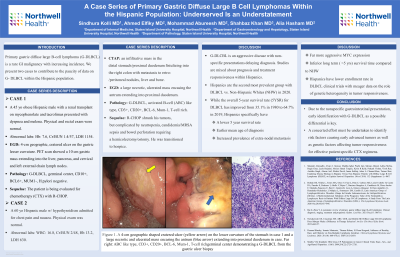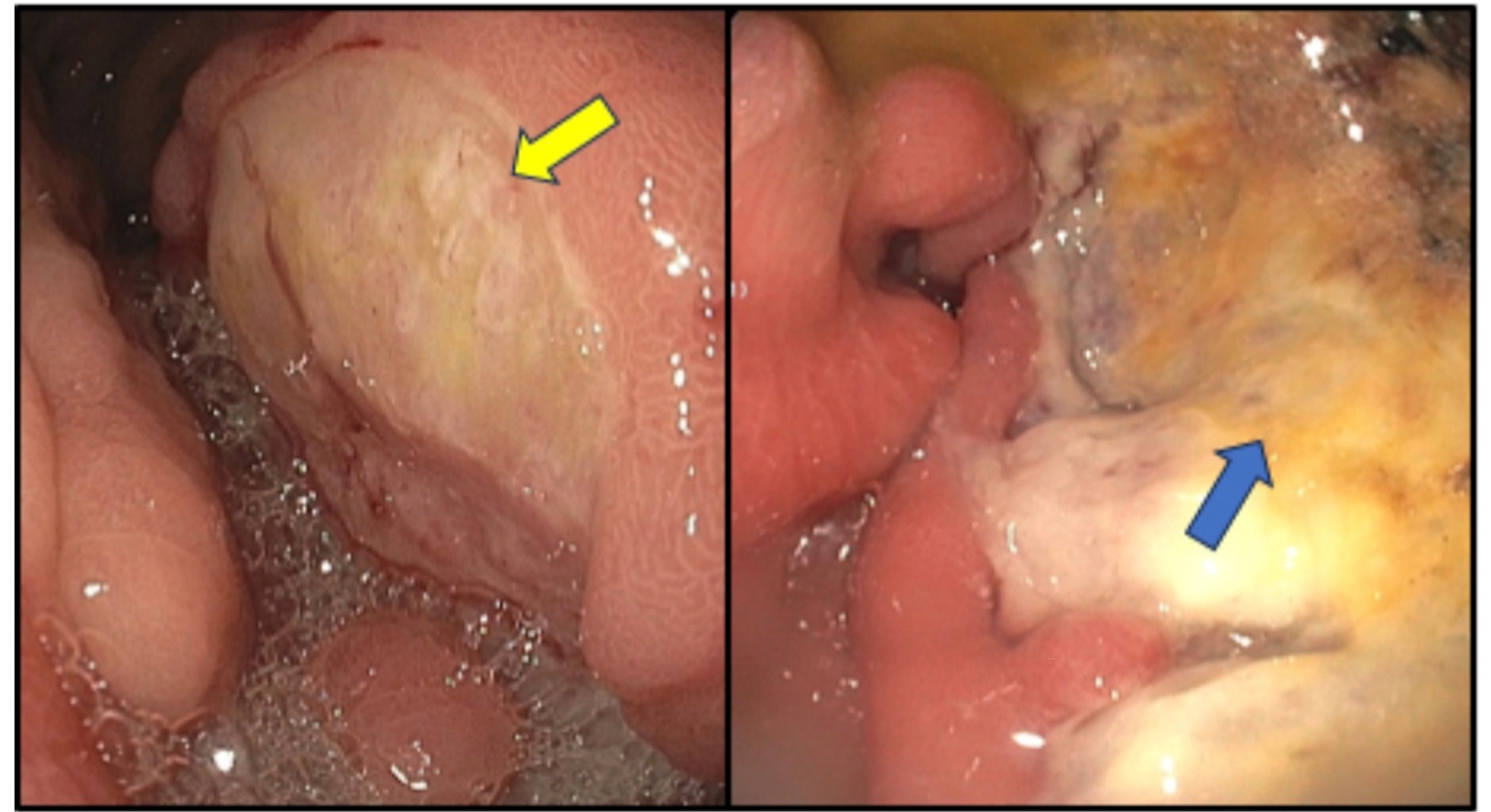Sunday Poster Session
Category: Stomach
P1371 - A Case Series of Primary Gastric Diffuse Large B Cell Lymphomas Within the Hispanic Population: Underserved Is an Understatement
Sunday, October 22, 2023
3:30 PM - 7:00 PM PT
Location: Exhibit Hall


Sindhura Kolli, MD
Staten Island University Hospital, Northwell Health
Staten Island, NY
Presenting Author(s)
Sindhura Kolli, MD1, Ahmed Elfiky, MD2, Mohammad Abureesh, MD2, Shahbaz Khan, MD3, Alia Hasham, MD4
1Staten Island University Hospital, Northwell Health, Staten Island, NY; 2Staten Island University Hospital Northwell Health, Staten Island, NY; 3Northwell Health, Staten Island University Hospital, Staten Island, NY; 4Staten Island University, Northwell Health, Staten Island, NY
Introduction: Primary gastric diffuse large B-cell lymphoma (G-DLBCL) is a rare gastrointestinal malignancy with increasing incidence. We present two cases in an effort to contribute to the paucity of data on G-DLBCL within the Hispanic population.
Case Description/Methods: A 45 year old (yo) obese Hispanic male with a renal transplant on mycophenolate and tacrolimus presented with dyspnea and melena. Physical and rectal exam were normal. Abnormal labs were a Hb of 7.6, Cr/BUN 1.4/57, LDH 1154. Esophagogastroduodenoscopy (EGD) demonstrated a 4-cm geographic, cratered ulcer on the gastric lesser curvature. Biopsies returned as a G-DLBCL, germinal center, CD10+, BCL6+, MUM1-, H.pylori negative. PET scan showed a 10 cm gastric mass extending into the liver, pancreas, and cervical and left external chain lymph nodes. The patient is being evaluated for chemotherapy (CTX) with R-CHOP.
A 60 yo Hispanic male with hypothyroidism admitted for chest pain and nausea. Physical exam was normal. Abnormal labs include WBC of 16.8, Cr/BUN 2/48, Hb 13.2, LDH 630. CT abdomen exhibited an infiltrative mass in the distal stomach/proximal duodenum fistulizing into the right colon with metastasis to retro-/peritoneal nodules, liver and bone. EGD showed a large necrotic, ulcerated mass encasing the antrum extending into proximal duodenum. Pathology returned as a G-DLBCL, activated B-cell (ABC) like type, CD3+, CD20+, BCL-6, Mum-1, T-cell rich. R-CHOP shrunk his tumors, but complicated by neutropenia, candidemia/MRSA sepsis and bowel perforation requiring a hemicolectomy/ostomy. He was transitioned to hospice.
Discussion: G-DLCBL is an aggressive disease with non-specific presentations delaying diagnosis. Studies are mixed about prognosis and treatment responsiveness within Hispanics. Hispanics are the second most prevalent group with DLBCL vs. Non-Hispanic Whites (NHW) in 2020. While the overall 5-year survival rate (5YSR) for DLBCL has improved from 35.1% in 1980 to 64.7% in 2019, Hispanics have a lower 5YSR, earlier mean age of diagnosis, increased prevalence of extra-nodal metastasis and aggressive MYC expression, inferior long term ( >5 yrs) survival time compared to NHW. Hispanics have lower enrollment rate in DLBCL clinical trials with meager data on the role of genetic heterogeneity in tumor responsiveness. A concerted effort must be undertaken to identify risk factors causing early advanced tumors as well as genetic factors affecting tumor responsiveness for effective patient specific CTX regimens.

Disclosures:
Sindhura Kolli, MD1, Ahmed Elfiky, MD2, Mohammad Abureesh, MD2, Shahbaz Khan, MD3, Alia Hasham, MD4. P1371 - A Case Series of Primary Gastric Diffuse Large B Cell Lymphomas Within the Hispanic Population: Underserved Is an Understatement, ACG 2023 Annual Scientific Meeting Abstracts. Vancouver, BC, Canada: American College of Gastroenterology.
1Staten Island University Hospital, Northwell Health, Staten Island, NY; 2Staten Island University Hospital Northwell Health, Staten Island, NY; 3Northwell Health, Staten Island University Hospital, Staten Island, NY; 4Staten Island University, Northwell Health, Staten Island, NY
Introduction: Primary gastric diffuse large B-cell lymphoma (G-DLBCL) is a rare gastrointestinal malignancy with increasing incidence. We present two cases in an effort to contribute to the paucity of data on G-DLBCL within the Hispanic population.
Case Description/Methods: A 45 year old (yo) obese Hispanic male with a renal transplant on mycophenolate and tacrolimus presented with dyspnea and melena. Physical and rectal exam were normal. Abnormal labs were a Hb of 7.6, Cr/BUN 1.4/57, LDH 1154. Esophagogastroduodenoscopy (EGD) demonstrated a 4-cm geographic, cratered ulcer on the gastric lesser curvature. Biopsies returned as a G-DLBCL, germinal center, CD10+, BCL6+, MUM1-, H.pylori negative. PET scan showed a 10 cm gastric mass extending into the liver, pancreas, and cervical and left external chain lymph nodes. The patient is being evaluated for chemotherapy (CTX) with R-CHOP.
A 60 yo Hispanic male with hypothyroidism admitted for chest pain and nausea. Physical exam was normal. Abnormal labs include WBC of 16.8, Cr/BUN 2/48, Hb 13.2, LDH 630. CT abdomen exhibited an infiltrative mass in the distal stomach/proximal duodenum fistulizing into the right colon with metastasis to retro-/peritoneal nodules, liver and bone. EGD showed a large necrotic, ulcerated mass encasing the antrum extending into proximal duodenum. Pathology returned as a G-DLBCL, activated B-cell (ABC) like type, CD3+, CD20+, BCL-6, Mum-1, T-cell rich. R-CHOP shrunk his tumors, but complicated by neutropenia, candidemia/MRSA sepsis and bowel perforation requiring a hemicolectomy/ostomy. He was transitioned to hospice.
Discussion: G-DLCBL is an aggressive disease with non-specific presentations delaying diagnosis. Studies are mixed about prognosis and treatment responsiveness within Hispanics. Hispanics are the second most prevalent group with DLBCL vs. Non-Hispanic Whites (NHW) in 2020. While the overall 5-year survival rate (5YSR) for DLBCL has improved from 35.1% in 1980 to 64.7% in 2019, Hispanics have a lower 5YSR, earlier mean age of diagnosis, increased prevalence of extra-nodal metastasis and aggressive MYC expression, inferior long term ( >5 yrs) survival time compared to NHW. Hispanics have lower enrollment rate in DLBCL clinical trials with meager data on the role of genetic heterogeneity in tumor responsiveness. A concerted effort must be undertaken to identify risk factors causing early advanced tumors as well as genetic factors affecting tumor responsiveness for effective patient specific CTX regimens.

Figure: Figure 1. A 4-cm geographic shaped cratered ulcer (yellow arrow) on the lesser curvature of the stomach in case 1 and a large necrotic and ulcerated mass encasing the antrum (blue arrow) extending into proximal duodenum in case 2
Disclosures:
Sindhura Kolli indicated no relevant financial relationships.
Ahmed Elfiky indicated no relevant financial relationships.
Mohammad Abureesh indicated no relevant financial relationships.
Shahbaz Khan indicated no relevant financial relationships.
Alia Hasham indicated no relevant financial relationships.
Sindhura Kolli, MD1, Ahmed Elfiky, MD2, Mohammad Abureesh, MD2, Shahbaz Khan, MD3, Alia Hasham, MD4. P1371 - A Case Series of Primary Gastric Diffuse Large B Cell Lymphomas Within the Hispanic Population: Underserved Is an Understatement, ACG 2023 Annual Scientific Meeting Abstracts. Vancouver, BC, Canada: American College of Gastroenterology.
